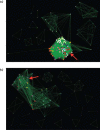Using a Novel Ontology to Inform the Discovery of Therapeutic Peptides from Animal Venoms
- PMID: 27570672
- PMCID: PMC5001765
Using a Novel Ontology to Inform the Discovery of Therapeutic Peptides from Animal Venoms
Abstract
Venoms and venom-derived compounds constitute a rich and largely unexplored source of potentially therapeutic compounds. To facilitate biomedical research, it is necessary to design a robust informatics infrastructure that will allow semantic computation of venom concepts in a standardized, consistent manner. We have designed an ontology of venom-related concepts - named Venom Ontology - that reuses an existing public data source: UniProt's Tox-Prot database. In addition to describing the ontology and its construction, we have performed three separate case studies demonstrating its utility: (1) An exploration of venom peptide similarity networks within specific genera; (2) A broad overview of the distribution of available data among common taxonomic groups spanning the known tree of life; and (3) An analysis of the distribution of venom complexity across those same taxonomic groups. Venom Ontology is publicly available on BioPortal at http://bioportal.bioontology.org/ontologies/CU-VO.
Figures



Similar articles
-
NCBO Ontology Recommender 2.0: an enhanced approach for biomedical ontology recommendation.J Biomed Semantics. 2017 Jun 7;8(1):21. doi: 10.1186/s13326-017-0128-y. J Biomed Semantics. 2017. PMID: 28592275 Free PMC article.
-
The clinical measurement, measurement method and experimental condition ontologies: expansion, improvements and new applications.J Biomed Semantics. 2013 Oct 8;4(1):26. doi: 10.1186/2041-1480-4-26. J Biomed Semantics. 2013. PMID: 24103152 Free PMC article.
-
Drug target ontology to classify and integrate drug discovery data.J Biomed Semantics. 2017 Nov 9;8(1):50. doi: 10.1186/s13326-017-0161-x. J Biomed Semantics. 2017. PMID: 29122012 Free PMC article.
-
Venom peptides as therapeutics: advances, challenges and the future of venom-peptide discovery.Expert Rev Proteomics. 2017 Oct;14(10):931-939. doi: 10.1080/14789450.2017.1377613. Epub 2017 Sep 13. Expert Rev Proteomics. 2017. PMID: 28879805 Review.
-
Diversity of peptide toxins from stinging ant venoms.Toxicon. 2014 Dec 15;92:166-78. doi: 10.1016/j.toxicon.2014.10.021. Epub 2014 Oct 28. Toxicon. 2014. PMID: 25448389 Review.
Cited by
-
Studying Smaller and Neglected Organisms in Modern Evolutionary Venomics Implementing RNASeq (Transcriptomics)-A Critical Guide.Toxins (Basel). 2018 Jul 16;10(7):292. doi: 10.3390/toxins10070292. Toxins (Basel). 2018. PMID: 30012955 Free PMC article. Review.
-
Informatics and Computational Methods in Natural Product Drug Discovery: A Review and Perspectives.Front Genet. 2019 Apr 30;10:368. doi: 10.3389/fgene.2019.00368. eCollection 2019. Front Genet. 2019. PMID: 31114606 Free PMC article. Review.
References
-
- Mafong DD, Henry RR. Exenatide as a treatment for diabetes and obesity: implications for cardiovascular risk reduction. Curr Atheroscler Rep. 2008;10:55–60. - PubMed
-
- Kaneto A, Kaneko T, Nakaya S, et al. Effect of bombesin infused intrapancreatically on glucagon and insulin secretion. Metab Clin Exp. 1978;27:549–53. - PubMed
Grants and funding
LinkOut - more resources
Full Text Sources
